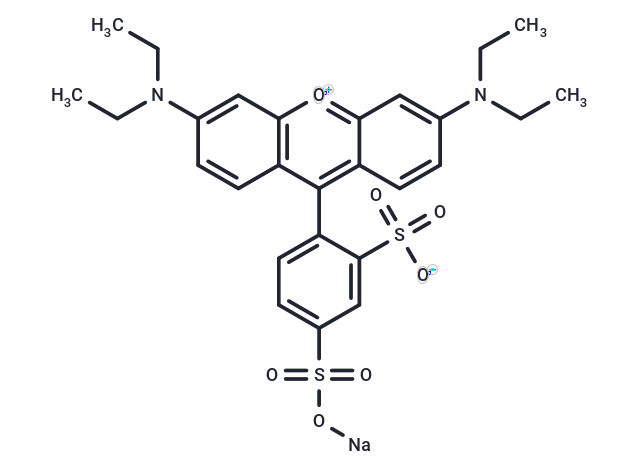Shopping Cart
Remove All Your shopping cart is currently empty
Your shopping cart is currently empty
Sulforhodamine B sodium salt (Acid Red 52) is a fluorescent dye. It can be used from laser-induced fluorescence to the quantification of cellular proteins of cultured cells.

| Pack Size | Price | USA Warehouse | Global Warehouse | Quantity |
|---|---|---|---|---|
| 1 g | $29 | In Stock | In Stock |
| Description | Sulforhodamine B sodium salt (Acid Red 52) is a fluorescent dye. It can be used from laser-induced fluorescence to the quantification of cellular proteins of cultured cells. |
| In vitro | Sulforhodamine B (SRB) is frequently used as a membrane-impermeable polar tracer and for cell density determination via cellular protein measurement (cytotoxicity assay). The SRB assay, divided into four steps—preparation of treatment, cell incubation, fixation, and SRB staining and absorbance measurement—permits inexpensive and sensitive manual or semiautomatic screening. It is applied in testing chemotherapeutic drugs or small molecules in adherent cells, evaluating gene expression modulation (knockdown, gene expression upregulation), and studying miRNA replacement effects on cell proliferation. |
| Cell Research | Instructions I. Solution preparation 1. Stock solution: Dissolve Sulforhodamine B sodium salt in an appropriate solvent (such as anhydrous DMSO or deionized water) to prepare a stock solution with a concentration of 1–10 mM. 2. Working solution: Dilute the stock solution to the working concentration according to the experimental needs, usually 0.05–0.1% (w/v) working solution. II. Operation steps 1. Cell culture: Inoculate an appropriate amount of cells into the culture dish to ensure that the cells grow to an appropriate density. 2. Staining: Add the working solution to the cell culture medium and incubate for about 30–60 minutes at room temperature or 37°C. 3. Washing: Wash the cells with PBS to remove unbound dye. 4. Fluorescence measurement: Observe or quantify fluorescence at 540 nm excitation and 560 nm emission wavelength using a fluorescence microscope or microplate reader. III. Application areas: 1. Cell proliferation and cytotoxicity test: Sulforhodamine B is often used to measure the changes in protein in cells after treatment, thereby reflecting the proliferation status or cell survival ability of cells. 2. Quantitative determination: The amount of cell protein can be quantified by measuring its fluorescence intensity after Sulforhodamine B staining. 3. Calibration and control: 1) Set up a control group without Sulforhodamine B to ensure the specificity and accuracy of the experiment. 2) A standard curve can be established with cell samples of known concentration to quantify the protein content. |
| Synonyms | Kiton Red 620, Acid Red 52 |
| Molecular Weight | 580.65 |
| Formula | C27H29N2NaO7S2 |
| Cas No. | 3520-42-1 |
| Smiles | O=S(C1=CC=C(C2=C3C=CC(N(CC)CC)=CC3=[O+]C4=C2C=CC(N(CC)CC)=C4)C(S(=O)([O-])=O)=C1)(O[Na])=O |
| Relative Density. | 1.472 g/cm3 at 20℃ |
| Color | Brown |
| Appearance | Solid |
| Storage | keep away from direct sunlight | Powder: -20°C for 3 years | In solvent: -80°C for 1 year | Shipping with blue ice/Shipping at ambient temperature. | ||||||||||||||||||||||||||||||||||||||||
| Solubility Information | DMSO: 80.83 mg/mL (139.21 mM), Sonication is recommended. H2O: 20 mg/mL (34.44 mM), Sonication is recommended. | ||||||||||||||||||||||||||||||||||||||||
Solution Preparation Table | |||||||||||||||||||||||||||||||||||||||||
H2O/DMSO
DMSO
| |||||||||||||||||||||||||||||||||||||||||
| Size | Quantity | Unit Price | Amount | Operation |
|---|

Copyright © 2015-2026 TargetMol Chemicals Inc. All Rights Reserved.